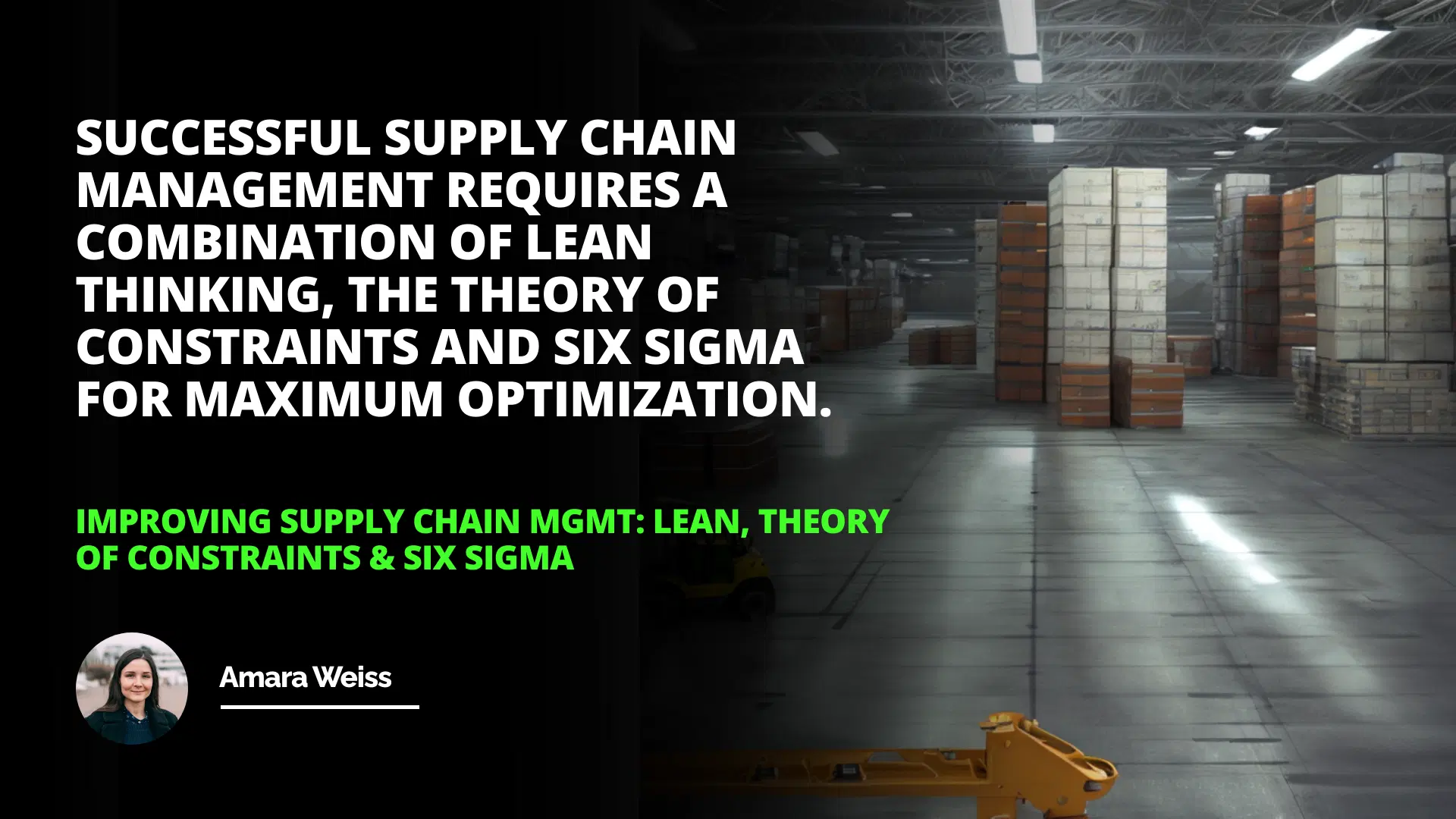
I still remember the day when our warehouse ground to a halt because of a simple miscommunication. We had trucks lined up outside, delivery schedules thrown off, and a lot of frustrated team members. It was a wake-up call for me about the complexities of supply chain management and the importance of continuous process improvement. Over the years, I've come to appreciate the myriad of strategies available to optimize these processes. In particular, Lean, the Theory of Constraints, and Six Sigma have become cornerstones in my approach to creating an efficient and competitive supply chain.
Introduction
Lean
Theory of Constraints
Six Sigma
Conclusion
Navigating the Complexities of Supply Chain Management
Supply chains are like living organisms; they are complex systems involving people, processes, and technologies all working in harmony. To stay ahead in today's fast-paced market, supply chains must continuously evolve and improve. This evolution isn't just about adopting the latest technology or software but also about refining the processes that underpin operations.
People are at the heart of any supply chain. Their education, training, and experiences shape how effectively the supply chain functions. Then there's technology—both hardware and software—that requires regular updates to keep up with industry advancements. But perhaps the most critical component is the processes themselves. Without efficient processes, even the most skilled people and advanced technology can't achieve optimal results.
My Journey to Process Improvement
Early in my career, I believed that throwing more resources at a problem would solve it. If we were behind schedule, we'd hire more staff or invest in new equipment. However, these solutions were often temporary fixes. It wasn't until I delved into process improvement methodologies that I realized the real key lay in optimizing our existing processes.
Lean: Eliminating Waste for Greater Efficiency
The Lean approach revolutionized the way I viewed our operations. Originating from the Toyota Production System, Lean focuses on eliminating waste—anything that doesn't add value from the customer's perspective. This waste can be in the form of excess inventory, unnecessary movements, waiting times, overproduction, overprocessing, defects, and underutilized talent.
The Seven Wastes
In Lean philosophy, there are seven types of waste to look out for:
1- Overproduction: Producing more than what is needed.
2- Waiting: Idle time when resources are not in use.
3- Transportation: Unnecessary movement of products or materials.
4- Overprocessing: Doing more work than necessary.
5- Inventory: Excess products not being processed.
6- Motion: Unnecessary movements by people.
7- Defects: Efforts involved in inspecting and fixing errors.
Identifying these wastes was an eye-opener. For instance, we realized that our warehouse was cluttered with inventory that wasn't moving, tying up capital and space. By implementing Lean principles, we managed to reduce inventory levels, streamline operations, and improve our overall efficiency.
Successful supply chain management requires a combination of lean thinking, the theory of constraints, and six sigma for maximum optimization.
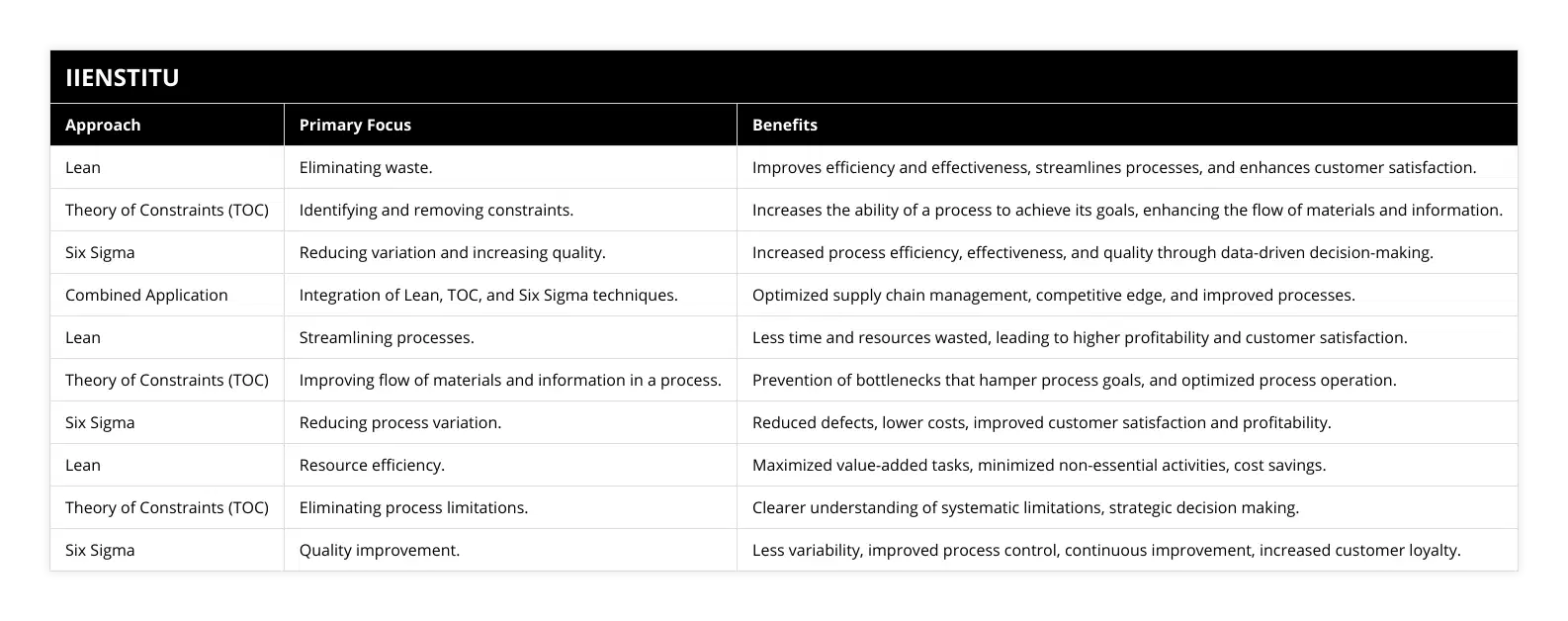
Tools and Techniques in Lean
Lean isn't just a philosophy; it's supported by practical tools like:
5S (Sort, Set in Order, Shine, Standardize, Sustain): A workplace organization method that enhances efficiency.
Kaizen: Continuous improvement involving everyone from managers to workers.
Value Stream Mapping: Visualizing the flow of materials and information to identify bottlenecks.
By adopting these tools, we not only eliminated waste but also improved employee morale, as team members felt more engaged in the process.
Theory of Constraints: Focusing on the Bottlenecks
While Lean helped us eliminate waste, the Theory of Constraints (TOC) offered a different lens. Proposed by Dr. Eliyahu M. Goldratt in his book The Goal, TOC centers on the idea that every system has at least one constraint that limits its performance.
Identifying the Constraint
A constraint could be a machine that's always backlogged, a policy that slows down decision-making, or even market demand. The TOC provides a five-step focusing process:
1- Identify the constraint.
2- Exploit the constraint by maximizing its utilization.
3- Subordinate other processes to the constraint.
4- Elevate the constraint's capacity.
5- Repeat the process for the next constraint.
In our case, we discovered that our packing station was the constraint. It couldn't handle the flow from the production line, causing delays. By reorganizing shifts and providing additional training, we exploited the constraint and improved our throughput.
Benefits of TOC
Improved flow: By focusing on constraints, the overall process becomes smoother.
Increased profitability: Optimizing the constraint can lead to better financial performance.
Enhanced focus: Teams concentrate on what truly matters.
Six Sigma: Reducing Variation for Quality Improvement
While Lean and TOC addressed efficiency and bottlenecks, Six Sigma brought quality into the spotlight. Developed by Motorola in the 1980s, Six Sigma aims for near-perfection by reducing process variation and eliminating defects.
The DMAIC Methodology
Six Sigma is structured around the DMAIC process:
1- Define the problem and project goals.
2- Measure current performance.
3- Analyze data to identify root causes.
4- Improve the process by addressing root causes.
5- Control the new process to sustain improvements.
Using Six Sigma, we tackled a chronic issue with order inaccuracies. By meticulously measuring and analyzing our processes, we identified that mislabeling was the primary culprit. Implementing barcode scanning at multiple points reduced errors dramatically.
Tools in Six Sigma
Statistical Process Control (SPC): Monitoring and controlling processes through statistics.
Failure Mode and Effects Analysis (FMEA): Proactively identifying where processes might fail.
Root Cause Analysis: Determining the fundamental cause of a defect.
Integrating Lean, TOC, and Six Sigma in Supply Chain Management
Initially, I viewed Lean, TOC, and Six Sigma as separate entities. However, over time, I realized that integrating them leads to a powerful synergy.
A Holistic Approach
Lean eliminates waste, ensuring processes are only as complex as they need to be.
TOC focuses efforts on the most critical part of the process—the constraint.
Six Sigma ensures that what's left is performed with high quality and minimal variation.
By combining these methodologies, we created a streamlined, efficient, and high-quality supply chain.
Practical Steps to Integration
1- Start with TOC: Identify and address the primary constraint.
2- Apply Lean Principles: Eliminate waste around the constraint to enhance its capacity.
3- Implement Six Sigma: Reduce variation in the constraint's processes for consistent performance.
For instance, after addressing our packing station constraint with TOC, we used Lean to eliminate unnecessary steps in the packing process. Then, Six Sigma tools helped us reduce errors, ensuring the station operated efficiently and effectively.
Benefits of Integration
Comprehensive Improvement: No aspect of the process is overlooked.
Enhanced Competitiveness: Streamlined operations lead to faster delivery times and better customer satisfaction.
Cost Reduction: Eliminating waste, optimizing constraints, and reducing defects save money.
Optimize Supply Chain Management Process Tips
If you're looking to optimize your supply chain, here are some tips based on my experiences:
Engage Your Team: Involve team members at all levels. Their insights are invaluable.
Continuous Training: Invest in ongoing education about Lean, TOC, and Six Sigma.
Measure Everything: You can't improve what you don't measure. Keep track of key performance indicators.
Embrace Technology: Utilize software tools for data analysis and process mapping.
Stay Customer-Centric: Always consider how changes impact the customer experience.
The Personal Impact of Process Improvement
Implementing these methodologies didn't just transform our supply chain; it transformed our company culture. Team members began thinking critically about their tasks, always seeking ways to improve. The collaborative environment fostered innovation and a shared sense of purpose.
One memorable moment was when a frontline worker suggested a minor change in the assembly line layout. This adjustment reduced unnecessary motion, saving time and effort. It was a testament to the power of empowering employees and cultivating a culture of continuous improvement.
Conclusion
Navigating the complexities of supply chain management is no small feat. However, through the strategic application of Lean, the Theory of Constraints, and Six Sigma, it's possible to create a supply chain that's not only efficient but also resilient and competitive.
These methodologies aren't mutually exclusive. In fact, their combined strength lies in addressing different facets of process improvement:
Lean cuts out the fat, ensuring every action adds value.
TOC shines a light on the weakest link, allowing for targeted improvements.
Six Sigma polishes the process, reducing errors and enhancing quality.
By embracing this holistic approach, supply chains can better adapt to market demands, reduce costs, and improve customer satisfaction.
Final Thoughts
Looking back on the day our warehouse operations came to a standstill, I realize it was a pivotal moment. It pushed us to reevaluate how we did things and opened the door to methodologies that have since become integral to our success. The journey toward process improvement is ongoing, but with the right tools and mindset, it's a journey well worth taking.
References
Goldratt, E. M. (1984). The Goal: A Process of Ongoing Improvement. North River Press.
Liker, J. K. (2004). The Toyota Way: 14 Management Principles from the World's Greatest Manufacturer. McGraw-Hill.
George, M. L., Rowlands, D., Price, M., & Maxey, J. (2005). The Lean Six Sigma Pocket Toolbook: A Quick Reference Guide to Nearly 100 Tools for Improving Quality and Speed. McGraw-Hill.
Womack, J. P., & Jones, D. T. (1996). Lean Thinking: Banish Waste and Create Wealth in Your Corporation. Simon & Schuster.
Ohno, T. (1988). Toyota Production System: Beyond Large-Scale Production. Productivity Press.
Pyzdek, T., & Keller, P. (2009). The Six Sigma Handbook: A Complete Guide for Green Belts, Black Belts, and Managers at All Levels. McGraw-Hill.
By integrating these strategies and embracing a culture of continuous improvement, we can all strive to make our supply chains more efficient, effective, and competitive in a rapidly changing world.
Frequently Asked Questions
How can Lean principles be applied to improve supply chain management?
Supply chain management is a critical factor for the success of any business. Lean principles have been widely adopted in production and operations to improve efficiency and reduce waste. In recent years, these principles have been applied to the realm of supply chain management to improve the performance of the entire supply chain system.
The Lean approach is based on identifying and eliminating waste in all areas of the supply chain. This includes reducing costs by improving processes, eliminating delays, and improving communication between stakeholders. The goal is to create a more efficient and effective supply chain that meets customer demands and minimizes costs.
One way to apply Lean principles to supply chain management is to focus on reducing inventory costs. By reducing the amount of inventory held, the supply chain can become more efficient and reduce costs. This can be achieved by utilizing technology to track inventory levels and identify any opportunities for improvement.
Additionally, implementing Just-in-Time (JIT) inventory management systems can help reduce inventory costs by ensuring that only the required inventory is held at any time.
Another way to apply Lean principles to supply chain management is to improve stakeholder communication. This includes establishing open lines of communication between suppliers, customers, and other stakeholders. By improving communication, the supply chain can deliver products and services to customers more efficiently. This can be achieved by using technology such as digital platforms, which enable real-time information sharing.
Finally, Lean principles can be used to improve customer service. This can be done by implementing customer feedback systems and data analysis to identify areas of improvement. The supply chain can be better equipped to meet customer demands by understanding customer needs.
Overall, Lean principles can improve supply chain management in several ways. Supply chain management can become more efficient and effective by reducing costs, improving communication, and increasing customer service. Implementing these principles will result in a more efficient and profitable supply chain that meets customer demands and minimizes costs.

What are the benefits of using the Theory of Constraints in supply chain management?
The Theory of Constraints (TOC) is a methodology that has been applied to supply chain management to improve the efficiency of the entire chain. TOC focuses on improving the supply chain's flow of materials, information, and processes to maximize its performance. The benefits of using TOC in supply chain management are numerous, some of which include increased cost savings, improved customer service, and increased flexibility.
One of the primary benefits of using TOC in supply chain management is cost savings. By identifying and eliminating bottlenecks in the supply chain, TOC allows for improved efficiency and reduced costs. Through improved planning and decision-making, TOC can help to reduce waste and increase the effectiveness of resources. This can lead to cost savings for the organization, as well as improved customer satisfaction.
TOC also helps to improve customer service in the supply chain. By identifying and eliminating bottlenecks, TOC can help to ensure that products are delivered on time, and that customer orders are fulfilled. This can lead to improved customer satisfaction and loyalty, which can help to increase sales and revenue.
Finally, TOC can help to increase the flexibility of the supply chain. By improving the flow of materials, information, and processes within the supply chain, TOC can help to reduce lead times, increase responsiveness, and enable the supply chain to adapt quickly to changes in customer demand. This can help the organization to remain competitive, as well as to meet customer needs better.
In conclusion, the Theory of Constraints can be a highly effective tool for improving the efficiency of the supply chain. By providing cost savings, improved customer service, and increased flexibility, TOC can help organizations reduce costs and improve customer satisfaction. As such, TOC is an invaluable tool for the supply chain management.
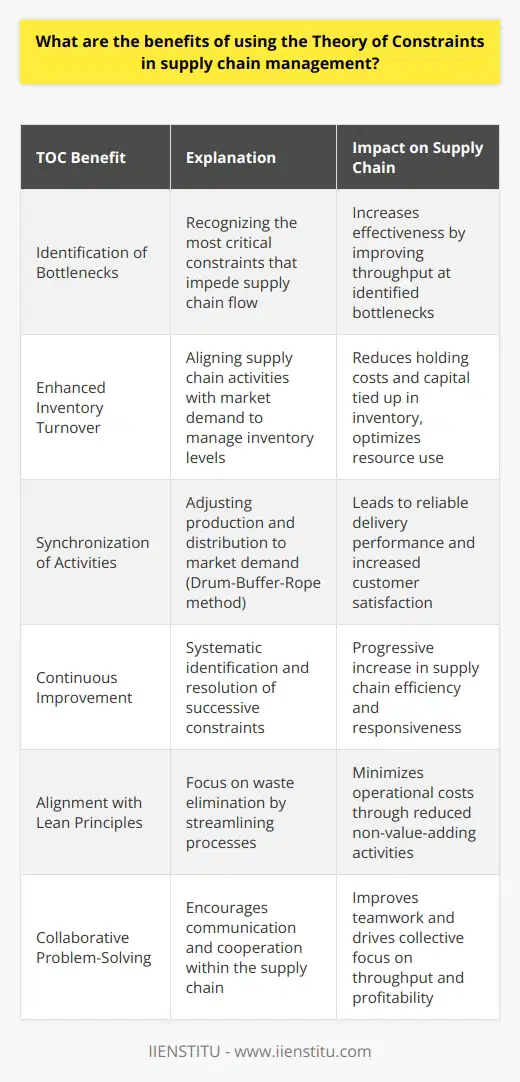
How can Six Sigma be used to optimize supply chain performance?
In the modern business landscape, supply chain performance is essential for organizational success. Companies are increasingly looking towards the Six Sigma methodology to improve supply chain performance. Six Sigma is a set of tools and processes used to measure, analyze and improve the performance of an organization. The core of the Six Sigma methodology is the DMAIC process, which stands for Define, Measure, Analyze, Improve, and Control.
The define phase is used to identify the key goals and objectives of the organization. This includes understanding the project's scope, identifying key stakeholders, and setting performance targets.
The measure phase involves gathering data and using it to develop performance metrics. This data is then analyzed to identify areas of inefficiency and potential improvements.
The analysis phase identifies the root cause of any issues and explores possible solutions. The Improve phase is used to develop and implement solutions.
Finally, the control phase monitors performance and ensures that the desired outcomes are achieved.
Six Sigma can be used to optimize supply chain performance in a variety of ways. For example, it can streamline processes, reduce costs, and improve customer satisfaction. It can also identify and eliminate non-value-added activities, improve inventory management, and reduce lead times. Additionally, Six Sigma can be used to identify areas of waste and implement process improvements to help increase efficiency and effectiveness.
The Six Sigma methodology can improve supply chain performance in several ways. By utilizing the DMAIC process, companies can identify areas of improvement, develop and implement solutions, and monitor performance over time. This can help increase the supply chain's efficiency and effectiveness, leading to improved performance and greater success.
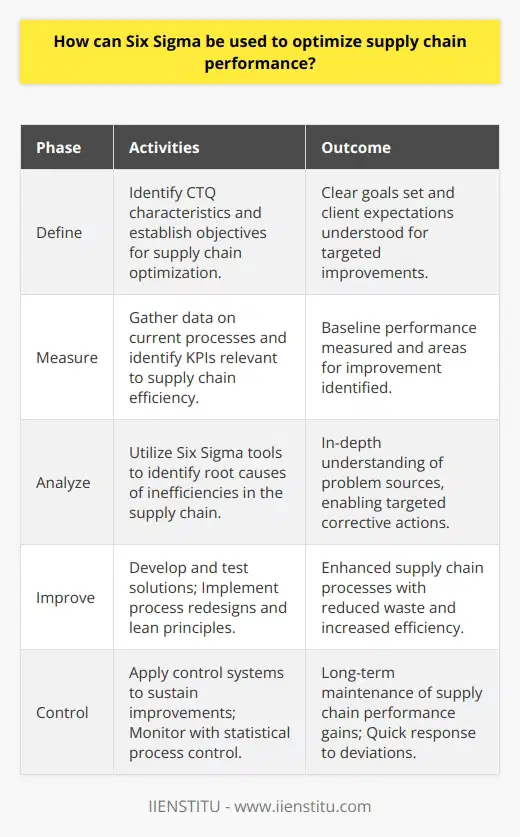
What is the relationship between the Theory of Constraints, Lean, and Six Sigma in supply chain optimization?
Overview of Optimization Techniques
The relationship between the Theory of Constraints (TOC), Lean, and Six Sigma in supply chain optimization lies in their shared objective to enhance overall efficiency and effectiveness within an organization. These methodologies, when combined, complement each other and help organizations identify and resolve issues in their supply chains.
Theory of Constraints
The Theory of Constraints, developed by Eliyahu M. Goldratt, is focused on identifying and managing the most critical constraint, or bottleneck, in a supply chain that limits the overall throughput. By prioritizing the improvement of the primary constraint, organizations can maximize their operational performance and achieve desired goals. TOC serves as a foundation to understand the limitations within a supply chain and to make strategic decisions accordingly.
Lean Methodology
Lean, derived from the Toyota Production System, aims to eliminate waste and non-value-added activities in a supply chain, thereby increasing process efficiency and reducing lead times. A Lean organization fosters a culture of continuous improvement, targeting a 'zero waste' scenario. By integrating Lean methodologies with TOC, companies can expedite the process of identifying and removing constraints, subsequently improving the capacity to achieve customer demands.
Six Sigma Approach
Six Sigma, pioneered by Motorola, is a data-driven methodology that strives to improve process performance by reducing variation and defects in the supply chain. Utilizing statistical tools and techniques, Six Sigma focuses on problem-solving and error minimization. This method can complement TOC and Lean by providing an analytical framework to assess the impact of eliminating constraints and reducing waste on the overall supply chain performance.
Synergies between TOC, Lean, and Six Sigma
In supply chain optimization, the synergistic application of TOC, Lean, and Six Sigma has proved to be effective in enhancing supply chain performance. The Theory of Constraints guides the identification of key constraints that need priority attention, Lean offers tools to eliminate waste and streamline processes while optimizing these constraints, and Six Sigma provides a structured, data-driven approach to achieve process excellence. By combining their individual strengths, companies can achieve a holistic, comprehensive optimization of their supply chains, resulting in improved customer satisfaction, increased efficiency, and reduced costs.
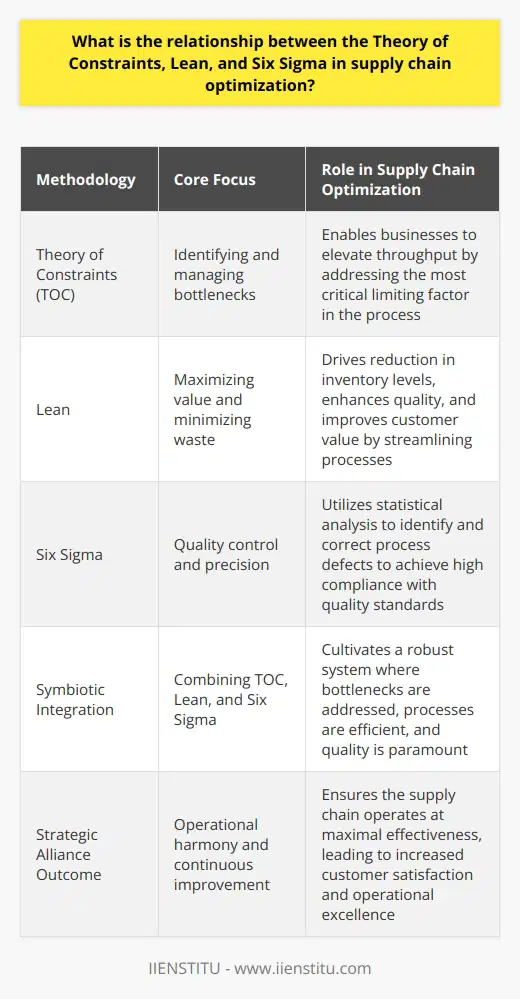
How can the integration of Lean Six Sigma and the Theory of Constraints lead to better supply chain performance?
Interrelation of Lean Six Sigma and Theory of Constraints
The integration of Lean Six Sigma (LSS) and the Theory of Constraints (TOC) can considerably enhance supply chain performance by merging the advantages of both methodologies. LSS focuses on reducing process waste and variation, while TOC emphasizes the identification and elimination of constraints limiting throughput. When employed in tandem, these approaches ensure a smooth and efficient supply chain process.
Identification and Elimination of Bottlenecks
TOC emphasizes the importance of identifying and addressing the factors that limit the overall efficiency of a system. In the context of supply chain management, these factors are often referred to as bottlenecks or constraints. The integration of TOC with LSS enables organizations to find these constraints and devise targeted solutions to enhance the functionality of their supply chains.
Reduced Waste and Process Variation
Lean Six Sigma aims to minimize waste and variability in processes, helping organizations achieve streamlined and efficient operations. In supply chain management, this means reducing lead times, ensuring product quality, and maintaining consistent delivery schedules. Integrating LSS and TOC helps organizations prioritize improvements, enabling them to optimize their supply chain strategies systematically.
Enhanced Resource Utilization
Both LSS and TOC focus on maximizing the use of available resources within a system. By maximizing resource utilization, organizations guarantee they are making the most efficient use of their human, capital, and physical assets. Integration of these methodologies ensures that supply chain resources are effectively allocated, reducing stockouts and preventing resource overloads.
Synchronized Processes
Integrating LSS and TOC enables organizations to synchronize their end-to-end supply chain processes. Synchronizing processes allows for more effective resource allocation, improved flow between processes, and reduced lead times. This results in a more rapid and efficient response to changing customer needs and improved supply chain performance.
In summary, the integration of Lean Six Sigma and the Theory of Constraints forms a powerful strategy for enhancing supply chain performance. By identifying and removing constraints, reducing waste and process variance, optimizing resource utilization, and synchronizing processes, organizations can create a more agile, responsive, and efficient supply chain to meet the evolving demands of their customers. With this approach, businesses can increase their competitiveness and achieve better overall performance.
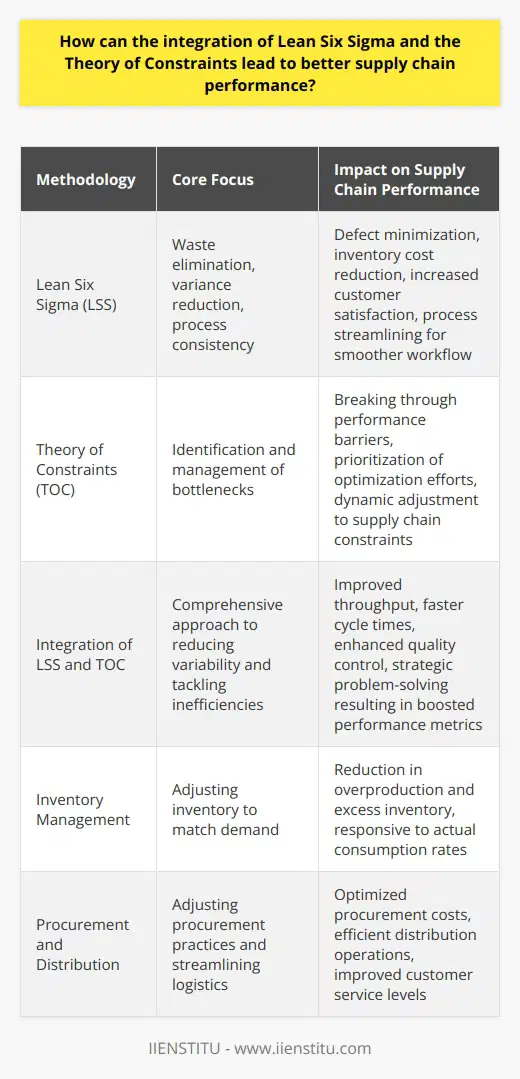
What are the key differences between Lean Six Sigma and the Theory of Constraints when applied to supply chain management?
Approach to Identifying Constraints
Lean Six Sigma (LSS) and the Theory of Constraints (TOC) are complementary continuous improvement methodologies. They possess fundamental differences when applied to supply chain management. Starting with their approach to identifying critical constraints, LSS relies on data-driven techniques, such as value stream mapping, to pinpoint efficiencies and waste-reduction opportunities. In contrast, TOC focuses on identifying the most significant bottleneck in the supply chain to improve overall throughput.
Addressing the Constraints
Once constraints are identified, the way LSS and TOC address them varies. LSS employs a wide range of tools and techniques such as DMAIC (Define, Measure, Analyze, Improve, Control) to reduce waste and variations in processes. TOC, on the other hand, takes a more targeted approach by focusing on solving the most prominent constraint using the Five Focusing Steps (Identify, Exploit, Subordinate, Elevate, and Iterate).
Scope of Application
The scope of application for these methodologies also differs. LSS targets the entire supply chain process, addressing multiple inefficiencies simultaneously. TOC's narrower perspective concentrates on only the most critical constraint, potentially creating a more focused effort. By prioritizing the constraint with the most significant impact on overall performance, TOC can deliver quicker results.
Perspective on Performance Measurement
Performance measurement also differentiates LSS and TOC. LSS uses a variety of key performance indicators (KPIs) to measure process improvements. These KPIs often address efficiency, defect rates, and process variability. TOC employs throughput accounting, a unique approach that prioritizes the rate of value generation over traditional financial measurements. Throughput accounting enables organizations to evaluate the effectiveness of addressing constraints more holistically.
Integration with Other Methodologies
Lastly, the integration capability of these two methodologies sets them apart. LSS is highly adaptable and can integrate with other frameworks such as Agile, Kaizen, and Total Quality Management. The singular focus on constraints in TOC may limit its compatibility with other methodologies, as it relies on a specific set of principles and tools to address constraints.
In conclusion, Lean Six Sigma and the Theory of Constraints have distinct approaches to identifying and addressing constraints, scope of application, performance measurement, and integration capabilities when applied to supply chain management. While both methodologies can yield significant improvements to organizational processes, organizations must consider these key differences and determine which methodology best aligns with their goals and needs.
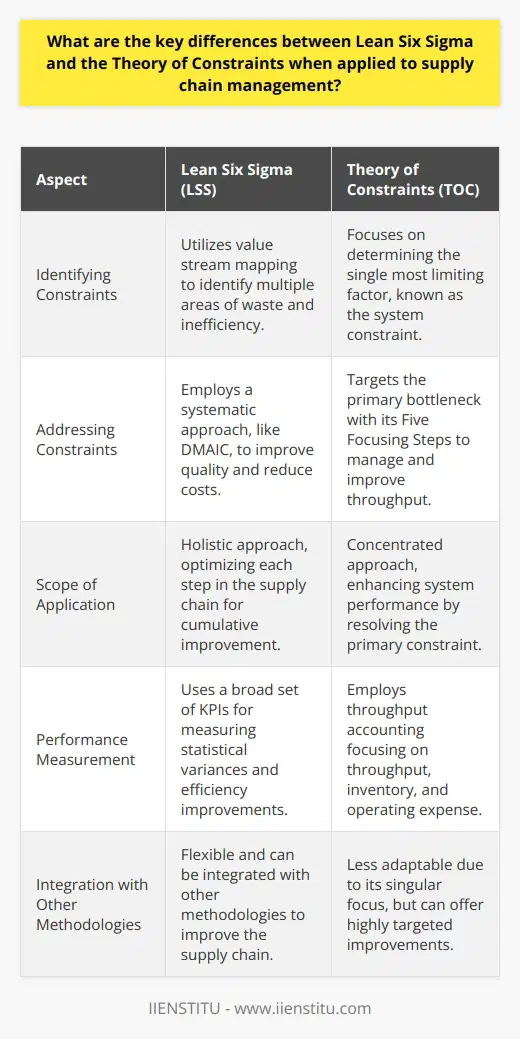
What is Lean and Six Sigma in supply chain management?
Overview of Lean and Six Sigma
Lean and Six Sigma are two widely accepted process improvement methodologies used in supply chain management. These approaches aim to enhance operational efficiency, reduce waste, and improve quality, leading to customer satisfaction and a competitive edge for organizations.
Lean Principles in Supply Chain
Originating from the Toyota Production System, Lean focuses on the identification and elimination of waste in supply chain processes. Its main objective is to achieve efficiency by removing non-value-added activities. The main categories of waste under Lean include overproduction, waiting, transportation, inventory, motion, over-processing, and defects. Lean implementation involves using various tools and techniques such as value stream mapping, 5S, and total productive maintenance.
Six Sigma for Quality Improvement
Six Sigma is a data-driven approach, aiming to reduce errors and inconsistencies in supply chain processes. Drawing from statistical tools and techniques, the goal of Six Sigma is to minimize process variation, thereby achieving a defect rate of 3.4 per million opportunities. This method follows either the DMAIC (Define, Measure, Analyze, Improve, and Control) or DMADV (Define, Measure, Analyze, Design, and Verify) framework, depending on the problem context. It also promotes building a culture of continuous improvement within an organization.
Integration for Optimal Results
While both Lean and Six Sigma offer distinct advantages, integrating the two methods can yield superior results, especially in supply chain management. By combining the waste reduction focus of Lean and the defect minimization goal of Six Sigma, organizations can optimize their supply chain performance. This integration leads to higher efficiencies, better quality products, and improved responsiveness to customer requirements. It also fosters an environment of continuous improvement, employee collaboration, and a cost-effective way to achieve organizational and strategic goals.
Conclusion
In conclusion, Lean and Six Sigma are powerful methodologies that, when employed separately or together, can significantly improve the effectiveness of supply chain management. Organizations must choose the right approach based on their needs, available resources, and desired outcomes. By adopting these methods, businesses can achieve operational excellence, higher customer satisfaction, and a competitive advantage in the market.
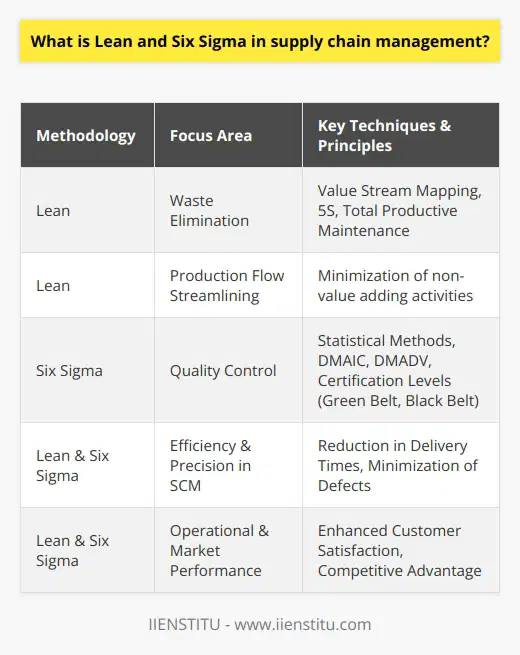
How can Lean Six Sigma make supply chain management better?
Enhancing Efficiency through Lean Six Sigma
Lean Six Sigma, a methodology combining the principles of Lean Manufacturing and Six Sigma, offers substantial benefits for supply chain management by emphasizing continuous improvement and waste reduction. The implementation of this approach helps companies streamline their processes, leading to increased efficiency, enhanced operational performance, and better responsiveness to customer needs.
Optimizing Resource Utilization
One way Lean Six Sigma contributes to better supply chain management is by ensuring the optimal use of available resources, including people, equipment, and materials. Through the identification and elimination of inefficient processes or operations, organizations can significantly reduce wasted time, effort and resources, resulting in reduced operational costs and increased return on investment.
Reducing Variability and Enhancing Quality
Lean Six Sigma aims to reduce process variability, a crucial factor affecting supply chain performance. By identifying and removing the root causes of variability through various problem-solving tools and statistical techniques, the methodology helps organizations achieve greater predictability and consistency in their processes. This, in turn, leads to improved product quality, increased customer satisfaction and higher profitability.
Fostering Collaboration and Communication
Lean Six Sigma encourages cross-functional collaboration and open communication within and among organizations. Its emphasis on process mapping and value stream analysis brings greater transparency to the supply chain, allowing stakeholders to identify potential areas of improvement and work together towards common goals. Improved communication and teamwork not only help to eliminate redundancies but also support more agile and responsive supply chains.
Enabling Continuous Improvement
A key aspect of Lean Six Sigma is its continuous improvement philosophy, which encourages organizations to constantly strive for better performance. This mindset drives supply chain stakeholders to regularly review and analyze performance metrics, identify bottlenecks, and develop solutions to address them. Through systematic and iterative improvements, Lean Six Sigma enables supply chains to adapt and evolve in response to changing market and customer demands.
In conclusion, Lean Six Sigma offers numerous benefits for supply chain management by focusing on efficiency improvements, variability reduction, enhanced communication, and a culture of continuous improvement. By adopting this approach, organizations can achieve more efficient, effective and responsive supply chains, ultimately resulting in higher customer satisfaction and sustained competitive advantage.
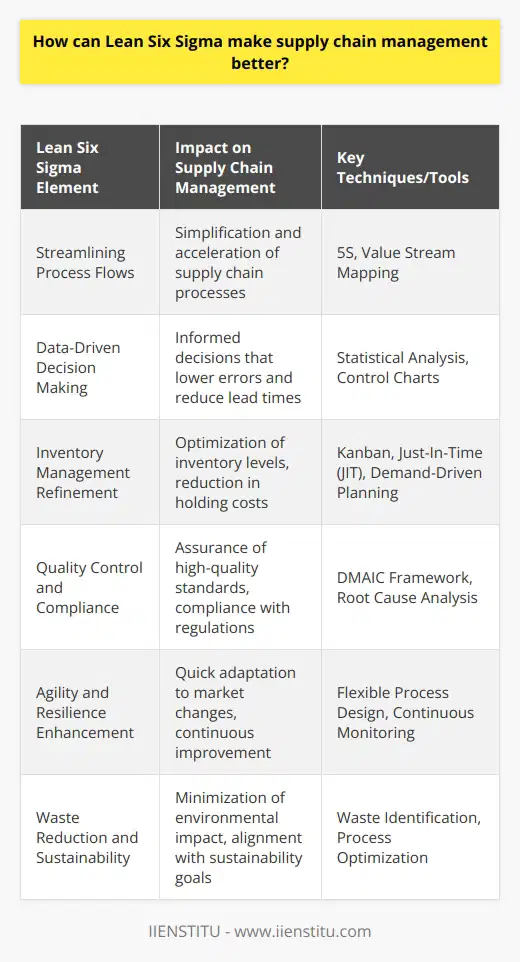
What is the Theory of Constraints in Lean and Six Sigma?
Introduction to the Theory of Constraints
The Theory of Constraints (TOC) is a methodology aimed at identifying and managing constraints limiting the performance of a system. Originally developed by Dr. Eliyahu Goldratt, this approach focuses on enhancing the efficiency, productivity, and profitability of a process or organization.
TOC in Lean and Six Sigma
In the context of Lean and Six Sigma, the Theory of Constraints serves as a useful model to optimize the flow of operations. Lean is a management philosophy geared towards minimizing waste while maximizing value for customers. Six Sigma, on the other hand, emphasizes reducing variability in processes to achieve consistent, high-quality results.
Identifying Constraints
To apply TOC in Lean and Six Sigma, the first step is to identify the bottlenecks constricting a system's throughput—the rate at which an operation can generate valuable outputs. These constraints correspond to the weakest links in production, hindering overall performance.
Exploiting Constraints
Once constraints are pinpointed, the next objective is to exploit them—that is, ensuring that the identified bottleneck operates at maximum efficiency. This calls for reducing downtime, minimizing setup time, and synchronizing the process flow at the constraint point.
Subordinating Other Processes
Since throughput is limited by constraints, it's crucial to align the performance of other processes to these bottlenecks. This subordination implies that non-constraint operations must adjust their pace to maintain a balanced, steady flow throughout the system.
Elevating the Constraint
To further improve process performance, the constraint must be elevated, or its throughput increased. This enhancement can be achieved through capacity expansion, technological upgrades, additional staffing, or streamlining the work process.
Repeat the Process
After elevating the constraint and achieving significant improvement, a new constraint might emerge. The process of identifying, exploiting, subordinating, and elevating should then be repeated, leading to continuous enhancement and growth.
Conclusion
In summary, the Theory of Constraints is an essential tool in Lean and Six Sigma to maximize operational efficiency and deliver consistent, high-quality outputs. By following the TOC's methodologies, organizations can successfully identify and address the bottlenecks limiting their productivity and performance, fostering continuous improvement and increased value for customers.
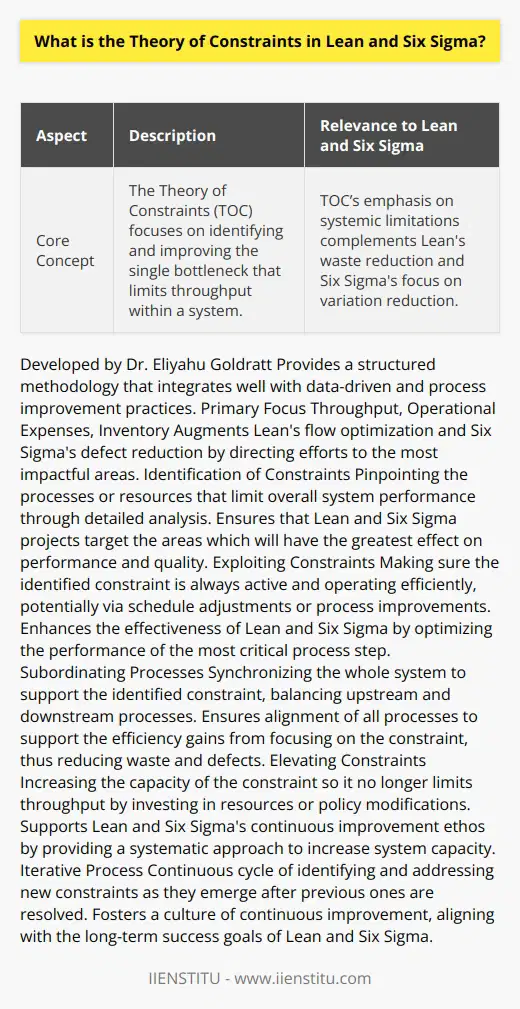
How do Lean Six Sigma and the Theory of Constraints complement each other in supply chain management?
Combining Lean Six Sigma and Theory of Constraints
Lean Six Sigma and the Theory of Constraints (TOC) are two well-established management methodologies that have proven their effectiveness in improving supply chain processes. While each approach has its unique strengths, their synergistic combination can yield even more significant results in supply chain management.
Streamlining Processes with Lean Six Sigma
Lean Six Sigma is a powerful methodology that aims to minimize waste, improve process efficiency, and enhance customer satisfaction in the supply chain. It involves the systematic identification and elimination of waste (non-value-added activities) in the supply chain processes using various tools and techniques, such as process mapping, value stream analysis, and root cause analysis. By applying Lean Six Sigma principles, businesses can significantly improve the overall performance of their supply chain, leading to reduced lead times, lower costs, increased throughput, and higher customer satisfaction levels.
Unlocking Bottlenecks with Theory of Constraints
The Theory of Constraints, on the other hand, focuses on identifying and addressing the most significant constraint or bottleneck that hampers the overall supply chain performance. TOC utilizes the 'Five Focusing Steps' (Identify, Exploit, Subordinate, Elevate, and Iterate) to systematically improve the weakest link in the supply chain, which then results in increased throughput, decreased inventory levels, and enhanced operational efficiency. By employing the TOC methodology, organizations can unleash the potential of their supply chain, allowing for sustained growth and profitability.
Enhancing Supply Chain Performance through Synergy
Both Lean Six Sigma and TOC methodologies are complementary, offering businesses a more holistic approach to enhance supply chain performance. Lean Six Sigma provides the framework for operational excellence through the elimination of waste and variability, while TOC emphasizes improving system-wide performance by addressing the primary constraint. By integrating these two methodologies, companies can create a comprehensive and balanced approach to supply chain management, capitalizing on the strengths of each method to maximize results.
In conclusion, the synergy between Lean Six Sigma and the Theory of Constraints enables organizations to achieve remarkable improvements in their supply chain management practices. By employing these methodologies in tandem, businesses can streamline their processes, eliminate constraints, and boost overall performance, leading to a more efficient, resilient, and competitive supply chain.
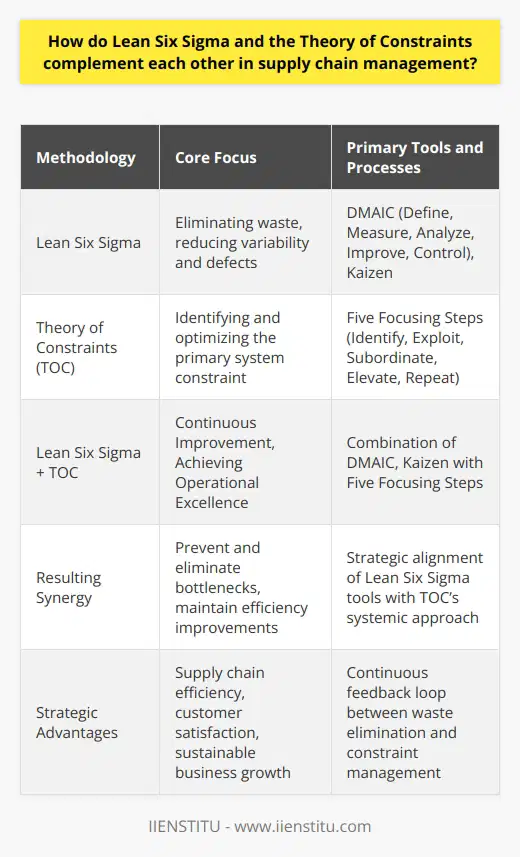
What are the challenges and potential solutions in implementing Lean Six Sigma within a global supply chain context?
Challenges in Implementing Lean Six Sigma
A global supply chain context presents several challenges when implementing Lean Six Sigma (LSS). One significant challenge is the cultural differences between various facilities and their employees. These dissimilarities can create difficulties in promoting Lean Six Sigma principles due to contrasting work attitudes, languages, and communication styles. As a result, the adoption of Lean Six Sigma methodologies, which require a strong commitment to continuous improvement and collaboration, can be hampered.
Additionally, the varying degrees of process maturity among global supply chain participants often lead to disparate levels of Lean Six Sigma adoption. This inconsistency, in turn, creates uneven benefits and outcomes. Consequently, firms face the challenge of aligning their strategic goals with those of their supply chain partners in order to optimize LSS implementation.
Potential Solutions for Successful Implementation
To address the challenges of cultural diversity, organizations must invest in the education and training of employees on Lean Six Sigma methodologies. This approach may involve developing customized training programs that take into consideration the cultural nuances and communication styles of different regions. It is crucial to ensure that employees from diverse backgrounds understand the benefits of LSS adoption and are motivated to participate actively.
Furthermore, organizations must establish a robust communication network among their global supply chain partners. By promoting transparent and consistent communication, firms can encourage a collaborative mindset and gain buy-in from all stakeholders. This collaboration is essential for sharing best practices, addressing concerns, and fostering a culture of continuous improvement across the entire supply chain.
Lastly, the alignment of strategic goals between global supply chain partners is critical for successful Lean Six Sigma implementation. Organizations must collaborate with their supply chain partners to establish mutually agreed-upon objectives and performance indicators. This alignment enables supply chain partners to work in tandem towards improving overall performance, reducing waste, and increasing customer satisfaction.
In conclusion, overcoming the challenges of implementing Lean Six Sigma in a global supply chain context requires organizations to consider cultural differences, invest in education and training, encourage collaboration, and align strategic goals among supply chain partners. By addressing these challenges, organizations can successfully implement Lean Six Sigma methodologies and optimize their global supply chain performance.

To what extent can the use of Lean Six Sigma methodology lead to significant improvements in supply chain sustainability and environmental performance?
Analysis of Lean Six Sigma in Supply Chain Sustainability
Effectiveness in Waste Reduction
The implementation of Lean Six Sigma methodology can contribute substantially to supply chain sustainability and environmental performance. One of the primary goals of this method is the reduction of waste in any form, including energy consumption, materials, and defects in production processes. By minimizing overproduced goods, excess inventory, and unnecessary transportation, companies can improve resource conservation, reduce carbon emissions, and decrease their environmental footprint.
Energy and Resource Efficiency
Aside from waste reduction, Lean Six Sigma also focuses on continuous improvement and efficient use of resources throughout the supply chain. Companies can optimize their manufacturing processes, transportation activities, and warehousing operations to enhance energy efficiency. This systematic approach to resource management can lead to significant financial savings and improved environmental performance, both of which are essential components of sustainable supply chain management.
Collaboration with Suppliers
Lean Six Sigma methodology also encourages collaboration with suppliers in pursuit of sustainability goals. Establishing long-term partnerships with environmentally responsible suppliers can facilitate the exchange of best practices and the implementation of innovative solutions to reduce waste and other negative environmental impacts. This collaborative approach to supply chain management contributes to improved environmental performance and further enhancement of supply chain sustainability.
Measurement and Reporting
Another aspect of Lean Six Sigma that supports sustainability initiatives is the emphasis on measurement and reporting. By setting quantifiable goals for reducing waste, energy use, and other resource-intensive activities, companies can continuously monitor their progress and identify areas that require further improvement. This data-driven approach ensures that organizations are held accountable for their environmental performance and are committed to making concrete, measurable progress toward more sustainable supply chain management.
Overall Impact on Sustainability and Environmental Performance
In summary, the adoption of Lean Six Sigma methodology can lead to significant improvements in supply chain sustainability and environmental performance by reducing waste, optimizing resource use, promoting collaboration with green suppliers, and fostering transparent measurement and reporting practices. The integration of this method to the overall supply chain management strategy can contribute greatly to more environmentally responsible and sustainable business operations.

What is the role of Lean Six Sigma in enhancing efficiency and reducing waste within supply chain processes?
Role of Lean Six Sigma in Supply Chain Efficiency
Lean Six Sigma plays a pivotal role in ameliorating efficiency and diminishing waste within various supply chain processes. It achieves this by combining Six Sigma's focus on process quality with Lean's emphasis on speed and efficiency.
Improving Process Quality
Six Sigma aims to reduce errors within supply chain processes. It seeks to minimize defects by identifying and eliminating the causes of variance. Through the application of statistical tools and techniques, it brings predictability and consistency in operational outcomes. Hence, this results in a reduction of costs incurred from errors and reworks.
Enhancing Speed and Efficiency
Concurrently, Lean focuses on removing unnecessary steps in the process flow. It strives to preserve value with less work, eliminating wasteful practices and non-value-added activities. Consequently, this reduces lead times, hence making processes more efficient.
Increasing Customer Satisfaction
Together, they endeavor to maximize process speed without compromising quality. This results in increased customer satisfaction through the delivery of high-quality products or services in a timely fashion.
Predictability Through Data Analysis
One unique feature of Lean Six Sigma is the data-centric approach. Through data analysis, it identifies key drivers of process variability and waste, paving the way for fact-based decision making.
In essence, Lean Six Sigma implements a dual approach. It optimizes efficiency and eliminates waste within supply chain processes, leading to improved performance and competitiveness in a cost-effective manner. The blend of Lean efficiency and Six Sigma's statistical analysis through data forms a robust strategy for supply chain management.
Overall, Lean Six Sigma is a powerful methodology for enhancing efficiency and reducing waste within supply chain processes. It offers the tools to analyze and improve every step of the supply chain, ensuring optimal efficiency and continuous flow of value.

How can implementing Lean Six Sigma methodologies contribute to more effective demand forecasting and inventory management in supply chain operations?
Improving Forecast Accuracy
Lean Six Sigma methodologies can heighten the accuracy of demand forecasting in supply chain operations. These techniques reduce forecasting errors by streamlining processes and mitigating variability. By adopting a data-driven approach, these methodologies amplify predictability. This predictive accuracy allows for smarter decision-making, contributing to better operational efficiency and customer service.
Streamlined Inventory Management
When it comes to inventory management, Lean Six Sigma can eradicate excess and waste. Minimizing stock levels while fulfilling demand is crucial. Lean approaches target these issues, optimizing stock levels, and reducing waste. By identifying and removing inefficiencies, these techniques improve the speed of the supply chain operation and reduce costs.
Synchronizing Supply with Demand
An important aspect is synchronizing supply with demand. Lean Six Sigma principles ensure the right amount of product is available at the right time. They incorporate statistical tools to analyze trends, fluctuation patterns, and demand cycles. These insights aid in aligning product availability and consumer demand, thereby, avoiding understock or overstock situations.
Incorporating these Lean Six Sigma methodologies into supply chain operations can revolutionize demand forecasting and inventory management. This facilitates an efficient, cost-effective operation that caters to customer needs while minimizing waste and maximizing profits. Hence, organizations striving for operational excellence should consider Lean Six Sigma as their go-to technique.
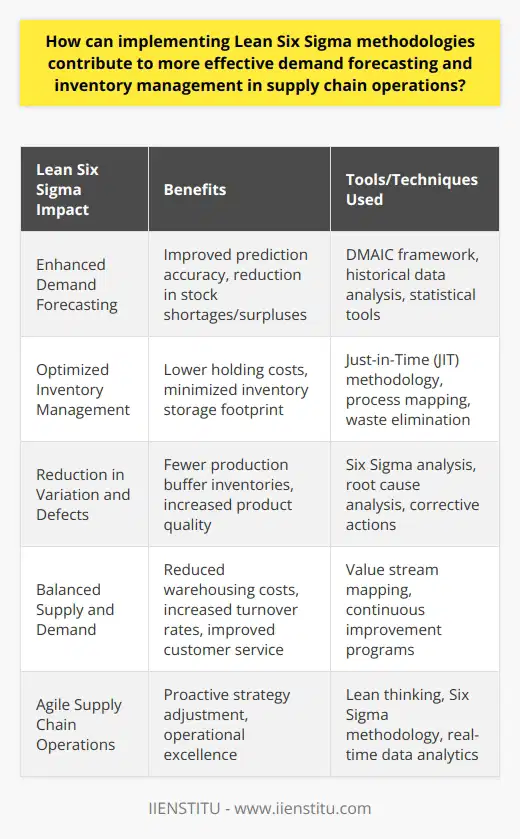
What are some common challenges encountered when incorporating Lean Six Sigma principles into complex and interconnected supply chain networks, and how can these challenges be overcome?
Incorporation Challenges
Incorporating Lean Six Sigma principles into complex and interconnected supply chain networks presents some common challenges. First, the high degree of complexity and interconnection in these networks can hinder full understanding of processes, limiting the effectiveness of Lean Six Sigma tools. Second, resistance among employees to change in established processes can also be a stumbling block.
Management Resistance
Resistance often manifests due to lack of understanding about the benefits of these principles, or fear about job security. Third, the need for substantial time and resource investment for successful implementation may deter organizations.
Knowledge Enhancement
Organizations can overcome these challenges through specific strategies. For one, to counter the complexity hurdle, organizations can invest in comprehensive training programs. These will enhance employee knowledge about the Lean Six Sigma methodology.
Comprehensive Communication
Addressing employee resistance requires an open and comprehensive communication strategy. This should aim to dispel fears and misconceptions surrounding Lean Six Sigma principles. Education on how the methodology enhances efficiency and reduces waste can be beneficial.
Adequate Investment
Lastly, organizations need to understand that the implementation of Lean Six Sigma is a long-term investment. Leaders must assure teams that the necessary time and resources for effective integration will be available. In the long run, organizations pursuing Lean Six Sigma will realize substantial time and cost savings, outweighing the initial investment. In conclusion, while there are challenges to implementing Lean Six Sigma principles into supply chains, they are not insurmountable. With careful planning, communication, and investment, organizations can effectively apply these principles for improved supply chain performance.

How is Six Sigma used to improve supply chain operations?
Role of Six Sigma in Supply Chain Improvement
Six Sigma plays an essential role in supply chain operations improvement. It strategically uses data and statistical analysis to identify and reduce errors. The technique aims to enhance performance, increase customer satisfaction, and improve profitability.
Six Sigma Techniques in Supply Chain Management
Six Sigma applies particular techniques such as DMAIC (Define, Measure, Analyze, Improve, Control) in supply chain operations. This process begins with defining the problem or inefficiencies in the supply chain. The next step involves measuring the existing system to gather data. This data then completes an analysis to identify the root causes of inefficiency.
Value of Six Sigma in Error Reduction
The primary focus of Six Sigma in supply chain management is error reduction. This methodology strives to achieve almost perfectly defect-free performance – 3.4 defects per million opportunities to be precise. Implementing Six Sigma helps organizations streamline their processes and cut down on waste, thus decreasing costs.
Six Sigma and Customer Satisfaction
Customer satisfaction is another area Six Sigma positively influences. By upscaling the quality of goods and services and reducing lead time, Six Sigma ensures customers receive their orders promptly and without errors. This prompt and efficient service effectively increases customer satisfaction levels.
Implementing Six Sigma in Supply Chain Optimization
Implementation of Six Sigma in supply chain operations results in increased efficiency and cost savings. It aids in minimizing variability in processes and products, which leads to more predictable and consistent outcomes. Also, it helps organizations to develop more robust supplier relations, improving overall supply chain functionality.
By harnessing the power of statistical analysis and a disciplined problem-solving approach, Six Sigma can contribute significantly to supply chain management. It actively supports the drive for continual improvement, enhancing the overall performance and profitability of the organization.

Is Lean Six Sigma useful for supply chain management?
Utility of Lean Six Sigma in Supply Chain Management
Lean Six Sigma, known for its efficiency improvements, is indeed valuable in supply chain management (SCM). It offers solutions to many supply chain issues.
Identification of Waste
One strength of Lean Six Sigma is its ability to identify waste. The process focuses on removing non-value adding activities. This ultimately results in cost savings and increased efficiency.
Improved Quality
Lean Six Sigma emphasizes quality control. It provides a structured mechanism to reduce variability. This guarantees the consistent quality of supply chain outputs.
Better Decision Making
Lean Six Sigma promotes data-based decision making. This method reduces guesswork. Consequently, the accuracy of decisions improves, driving overall performance of the supply chain.
Increased Flexibility
Flexibility is crucial in contemporary SCM. Lean Six Sigma fosters adaptability because it supports continuous improvement. It aids in adjusting swiftly to evolving demands and market trends.
Boost Distributions and Inventory Management
Lean Six Sigma contains techniques to streamline the supply chain. It can optimize inventory management and smoother distributions. Consequently, it reduces the lead-time: the period from initiation to completion of a process.
Enhanced Customer Satisfaction
Lean Six Sigma directly links to customer satisfaction. It ensures the highest level of product or service quality. As a result, it delights customers and boosts brand loyalty.
In sum, Lean Six Sigma provides substantial benefits for supply chain management. It offers systematic processes to boost efficiency, minimize waste and increase flexibility. Therefore, it's an essential technique for today's supply chain managers.

What is the Theory of Constraints in Lean Six Sigma and how does it apply to supply chain optimization?
Theory Overview
The Theory of Constraints (TOC) in Lean Six Sigma is a management philosophy. It centers on the principle that any manageable system only becomes restrained from achieving its peak level of performance via a small number of blocks or constraints.
Theory Application in Lean Six Sigma
In the context of Lean Six Sigma, organizations use TOC to boost efficiency. They do this by identifying, prioritizing and reducing constraints that hinder process optimization. This step aligns with Lean Six Sigma's 'define, measure, analyze, improve, control' (DMAIC) methodology.
Impact on Supply Chains
Supply chain optimization is a primary application area of the TOC. Here, organizations regard constraints as leverage points to increase throughput, reduce inventory, and decrease operational expense. Any block can affect the entire supply chain output and performance, hence it is crucial to locate and eliminate these.
Process Identification and Improvement
The first step involves identifying the limiting factor or constraint that keeps the supply chain from achieving its goal. It forms the narrowest point in the chain that determines the system's overall capacity.
Following the constraint identification, the next step is exploiting it. It requires making sure that the processes directly before and after the constraint, known as adjoining processes, run as smoothly as possible. They should have maximum efficiency to ensure that the blockade does not worsen.
Strategic Use of Buffer Stocks
In the content of supply chain management, buffer stocks play a crucial role. They act as a cushion for predicted and unpredictable disruptions in the supply chain. TOC focuses on strategically placing these buffer stocks to ensure a steady flow of materials, despite potential blockages.
Additional Steps in TOC
Once an organization alleviates the identified constraint, it then classifies the next possible constraint and repeats the same process. It is a cycle of continuous improvement, which is a key principle in Lean Six Sigma.
Thus, TOC in Lean Six Sigma is a powerful theory for streamlining operations. It improves supply chain efficiency by treating constraints not as roadblocks, but as opportunities for enhancement.



